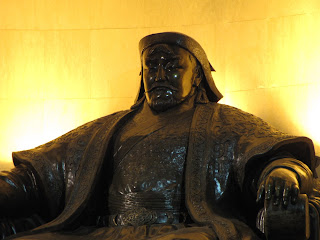Hazāra In the Gobi
(Babur and Humayun, painted as having Mongol or Hazara features by a Persian miniaturist c. 17th century.)
An Unimog personnel-carrier draws up behind the kitchen ger, carrying another postscript to the story of the last Khwarezm-Shah. The monster-truck is emblazoned with the livery of a logistics-support-company, and it is trailing some intrepid Swedes walking across the Gobi. The hatch at the back opens; their cook emerges to borrow water and greens from our cook, to make hot dinners for the tribe of walkers now camped out in the steppe. There is also some mechanical trouble with the Unimog, and soon our driver (whose day job is Automotive-Repair-Instructor at the vocational college in Dalanzadgad) has crawled underneath the chassis. Some of the most illuminating moments in travel occur when one is in the company of the drivers, squatting and drinking tea, proffering politely-useless commentary on unfamiliar drivetrain; in this case, the driver of the Unimog has only a light knowledge of his heavy vehicle, but very interesting features and a very giveaway name - Imam Bakhsh Hazāra.
The Hazāra (Persian: هزاره) are a people who used to be concentrated in the Hazārajat, i.e. in central Afghanistan around Bamiyan, but who, after a century of persecution coupled with ethnic-cleansing, are now a global diaspora. They are overwhelmingly Twelver-Shia Muslims, and are said to still make up the third largest ethnic group of Afghanistan, comprising ~10% of the population - say 3 to 5 million souls overall. More than a million more live as refugees in Iran, and a comparable number are based around Quetta in Pakistan.
The physical attributes of the Hazāra, especially their faces and eyes, as well as parts of their culture and language, resemble those of the Mongolians and Central Asian Turks. It is thus widely and popularly believed that Hazāra have Mongolian ancestry, and legend talks about a Mongol minggan (unit of a thousand soldiers) returning from skirmishes with Jalaluddin Manguberdi in Bamiyan, settling down in the area, and taking local wives. The Hazāra speak an archaic Persian, heavy with loanwords from Mongolian, and the conventional theory is that word Hazāra most likely derives from the Persian word for thousand (Persian: هزار - hazār) in memory of the original Mongol minggan. (Another place where a Mongol tuman, unit of 10,000 soldiers, may have settled is Tyumen (Russian: Тюмень), the center of Tyumen Oblast, Russia, located on the Tura River 1,700 kilometers east of Moscow.)
There is also speculation that the term Hazāra may be derived from Chingis Khan's brother Khasar (Hazar), whose descendants competed with the lineage descended from Hülegü (son of Chingis Khan's youngest son Tolui), who ruled as the Il-Khan in ʿIrāq-i ʿAjam and the Khorasān. This theory claims that with the rise of the Timurid Mughals, the Mongols serving the Hazarid Khans distinguished themselves from the new Moghul invaders by calling themselves Hazāra, the etymological root Khasar being by now lost among the people. Babur, the founder of the Mughal Empire in the early 16th century, records the name Hazāra in Baburnama, so if this theory is correct, the Hazarid endonymy must have morphed quite rapidly.
It is most likely that the Hazāra are descended from Mongol military forces, but that these forces came in multiple waves. Nikudari Mongols settled in eastern Persia and mixed with native populations who spoke Persian. A second wave of Khasarid and Chagatai Mongols came from Central Asia; they were followed by other Mongolic groups, associated with the Ilkhanate and the Timurids; all of these waves of Mongol men settled in the Hazārajat and mixed with the local, mostly Persian-speaking population, descendants of the Kushans (whose massive achievement in art and architecture still litter Bamiyan), forming a distinct group. The local wives the soldiers took were by that time Shia, and the children are, to this day, Shia; this heterodoxy, coupled with their status as "progeny of invaders" in the eyes of the Sunni Pashtun, has invited the wrath of the "more-native" tribes against the Hazāra many, many times.
Genetically, the Hazāra are primarily eastern Eurasian with western Eurasian genetic mixtures, clustering closely with the Uzbek population of the Afghanistan, both groups being at a notable distance from Afghanistan's Tajik and Pashtun populations. There is evidence of a patrimonial relation to Mongol peoples of Mongolia - "the Y-chromosome of Chingis Khan" is present in a greater proportion in the Hazāra men than it is in even the current population of Mongolian men. This chromosome is virtually absent outside the limits of the Mongol Empire; among the Hazāra, it reaches its highest frequency anywhere in the world - see the blue pie-slice in the graphic below. The Hazāra are also characterized by very high frequencies of eastern-Eurasian mtDNA at 35%, and these are virtually absent from neighboring populations, suggesting that the male descendants of Chingis Khan, or other Mongols of his clan, were accompanied by some women of East Asian ancestry, perhaps the Tatar Bekis of the princes. Women of non-eastern-Eurasian mtDNA in the Hazāra are at 65%, most which is western-Eurasian (possibly Kushano-Bactrian), with the remainder North-Indian.
When you go to Ulaanbaatar - he tells me confidingly - there is a restaurant called the Hazāra. Of course it has nothing to do with the Hazāra. It is Indian. You will like it.
Here is part one of a documentary on the history of the Hazāra. Part two is here. The Pashtun and Tajik cultural memory of Chingis Khan's foray into Afghanistan is one of a holocaust resisted. Below is a clip that reflects that memory - "Genghis Khan said he would spare everyone that surrendered but of course the Afghans did not", and "most ethnic groups from present day Afghanistan rose up and fought." In this memory, the Hazāra did fight, but on the other side.














_Cuman_(right).jpg)















